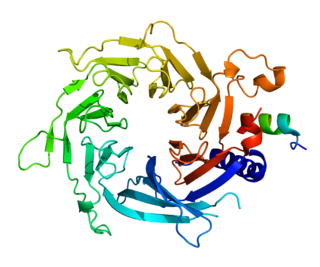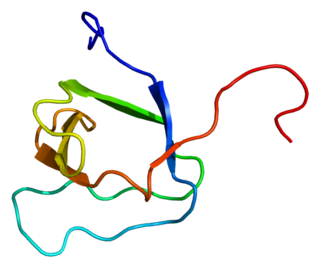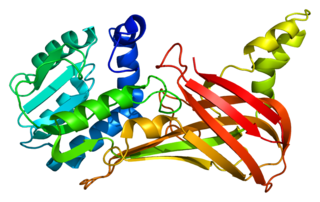Protein arginine N-methyltransferase 1 is an enzyme that in humans is encoded by the PRMT1 gene. [5] The HRMT1L2 gene encodes a protein arginine methyltransferase that functions as a histone methyltransferase specific for histone H4. [6]
Protein arginine N-methyltransferase 1 is an enzyme that in humans is encoded by the PRMT1 gene. [5] The HRMT1L2 gene encodes a protein arginine methyltransferase that functions as a histone methyltransferase specific for histone H4. [6]
PRMT1 gene encodes for the protein arginine methyltransferase that functions as a histone methyltransferase specific for histone H4 in eukaryotic cells. [6] Specifically altering histone H4 in eukaryotes gives it the ability to remodel chromatin acting as a post-translational modifier. [7]
Through regulation of gene expression, arginine methyltransferases control the cell cycle and death of eukaryotic cells. [7]
While all PRMT enzymes catalyze the methylation of arginine residues in proteins, PRMT1 is unique in that is catalyzes the formation of asymmetric dimethylarginine as opposed to the PRMT2 that catalyzes the formation of symmetrically dimethylated arginine. [8] Individual PRMT utilize S-adenosyl-L-methionine (SAM) as the methyl donor and catalyze methyl group transfer to the ω-nitrogen of an arginine residue. [8]
In humans, these enzymes regulate gene expression and hence are involved in pathogenesis of many human diseases. [9] Using enzyme inhibitors for arginine methyltransferase 1, studies were able to demonstrate the enzyme's potential as an early catalyst of various cancers. [9] [8] [10]
PRMT1 has been shown to interact with:

In biology, histones are highly basic proteins abundant in lysine and arginine residues that are found in eukaryotic cell nuclei and in most Archaeal phyla. They act as spools around which DNA winds to create structural units called nucleosomes. Nucleosomes in turn are wrapped into 30-nanometer fibers that form tightly packed chromatin. Histones prevent DNA from becoming tangled and protect it from DNA damage. In addition, histones play important roles in gene regulation and DNA replication. Without histones, unwound DNA in chromosomes would be very long. For example, each human cell has about 1.8 meters of DNA if completely stretched out; however, when wound about histones, this length is reduced to about 90 micrometers (0.09 mm) of 30 nm diameter chromatin fibers.

Histone methyltransferases (HMT) are histone-modifying enzymes, that catalyze the transfer of one, two, or three methyl groups to lysine and arginine residues of histone proteins. The attachment of methyl groups occurs predominantly at specific lysine or arginine residues on histones H3 and H4. Two major types of histone methyltranferases exist, lysine-specific and arginine-specific. In both types of histone methyltransferases, S-Adenosyl methionine (SAM) serves as a cofactor and methyl donor group.
The genomic DNA of eukaryotes associates with histones to form chromatin. The level of chromatin compaction depends heavily on histone methylation and other post-translational modifications of histones. Histone methylation is a principal epigenetic modification of chromatin that determines gene expression, genomic stability, stem cell maturation, cell lineage development, genetic imprinting, DNA methylation, and cell mitosis.

Histone H4 is one of the five main histone proteins involved in the structure of chromatin in eukaryotic cells. Featuring a main globular domain and a long N-terminal tail, H4 is involved with the structure of the nucleosome of the 'beads on a string' organization. Histone proteins are highly post-translationally modified. Covalently bonded modifications include acetylation and methylation of the N-terminal tails. These modifications may alter expression of genes located on DNA associated with its parent histone octamer. Histone H4 is an important protein in the structure and function of chromatin, where its sequence variants and variable modification states are thought to play a role in the dynamic and long term regulation of genes.
Histone methylation is a process by which methyl groups are transferred to amino acids of histone proteins that make up nucleosomes, which the DNA double helix wraps around to form chromosomes. Methylation of histones can either increase or decrease transcription of genes, depending on which amino acids in the histones are methylated, and how many methyl groups are attached. Methylation events that weaken chemical attractions between histone tails and DNA increase transcription because they enable the DNA to uncoil from nucleosomes so that transcription factor proteins and RNA polymerase can access the DNA. This process is critical for the regulation of gene expression that allows different cells to express different genes.
Chromatin remodeling is the dynamic modification of chromatin architecture to allow access of condensed genomic DNA to the regulatory transcription machinery proteins, and thereby control gene expression. Such remodeling is principally carried out by 1) covalent histone modifications by specific enzymes, e.g., histone acetyltransferases (HATs), deacetylases, methyltransferases, and kinases, and 2) ATP-dependent chromatin remodeling complexes which either move, eject or restructure nucleosomes. Besides actively regulating gene expression, dynamic remodeling of chromatin imparts an epigenetic regulatory role in several key biological processes, egg cells DNA replication and repair; apoptosis; chromosome segregation as well as development and pluripotency. Aberrations in chromatin remodeling proteins are found to be associated with human diseases, including cancer. Targeting chromatin remodeling pathways is currently evolving as a major therapeutic strategy in the treatment of several cancers.

Histone-binding protein RBBP4 is a protein that in humans is encoded by the RBBP4 gene.

Histone-lysine N-methyltransferase SUV39H1 is an enzyme that in humans is encoded by the SUV39H1 gene.

Histone-binding protein RBBP7 is a protein that in humans is encoded by the RBBP7 gene.

Protein arginine N-methyltransferase 5 is an enzyme that in humans is encoded by the PRMT5 gene. PRMT5 symmetrically dimethylates H2AR3, H4R3, H3R2, and H3R8 in vivo, all of which are linked to a range of transcriptional regulatory events.

Polyadenylate-binding protein 2 (PABP-2) also known as polyadenylate-binding nuclear protein 1 (PABPN1) is a protein that in humans is encoded by the PABPN1 gene. PABN1 is a member of a larger family of poly(A)-binding proteins in the human genome.

Eukaryotic translation initiation factor 3 subunit A (eIF3a) is a protein that in humans is encoded by the EIF3A gene. It is one of the subunits of Eukaryotic initiation factor 3 (eIF3) a multiprotein complex playing major roles in translation initiation in eukaryotes.

DNA methyltransferase 1-associated protein 1 is an enzyme that in humans is encoded by the DMAP1 gene.

Histone cluster 2, H3, pseudogene 2, also known as HIST2H3PS2, is a human gene.

Serine/threonine-protein kinase 38 is an enzyme that in humans is encoded by the STK38 gene.

Protein arginine N-methyltransferase 2 is an enzyme that in humans is encoded by the PRMT2 gene.

N-lysine methyltransferase KMT5A is an enzyme that in humans is encoded by the KMT5A gene. The enzyme is a histone methyltransferase, SET domain-containing and lysine-specific. The enzyme transfers one methyl group to histone H4 lysine residue at position 20. S-Adenosyl methionine (SAM) is both the cofactor and the methyl group donor. The lysine residue is converted to N6-methyllysine residue.

Protein arginine N-methyltransferase 6 is an enzyme that in humans is encoded by the PRMT6 gene.

Interferon-alpha/beta receptor alpha chain is a protein that in humans is encoded by the IFNAR1 gene.

Protein arginine N-methyltransferase 3 is an enzyme that in humans is encoded by the PRMT3 gene.
Protein methylation is a type of post-translational modification featuring the addition of methyl groups to proteins. It can occur on the nitrogen-containing side-chains of arginine and lysine, but also at the amino- and carboxy-termini of a number of different proteins. In biology, methyltransferases catalyze the methylation process, activated primarily by S-adenosylmethionine. Protein methylation has been most studied in histones, where the transfer of methyl groups from S-adenosyl methionine is catalyzed by histone methyltransferases. Histones that are methylated on certain residues can act epigenetically to repress or activate gene expression.